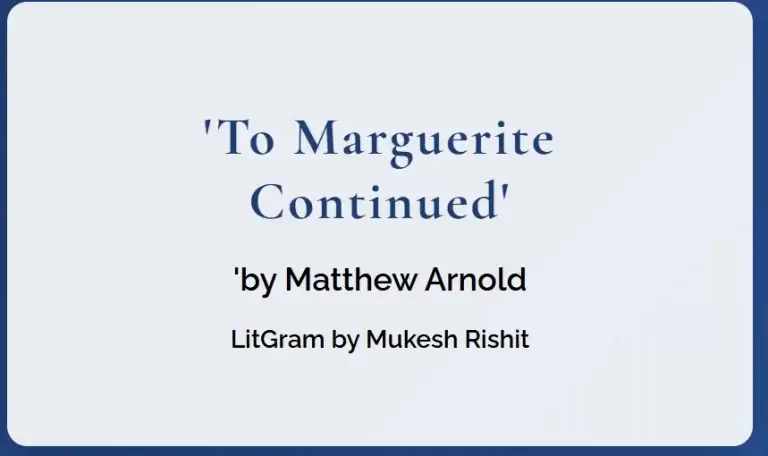Matthew Arnold’s “To Marguerite Continued” is a profound exploration of human isolation and emotional connection that resonates with readers across generations. This poem, written as a follow-up to “To Marguerite, in Returning a Volume of the Letters of Ortis,” captures Arnold’s characteristic blend of personal sentiment and philosophical inquiry. This analysis will explore the poem’s key themes, literary devices, and enduring relevance to modern readers.
The Historical Context of “To Marguerite Continued”
Matthew Arnold wrote “To Marguerite Continued” in 1852, during the Victorian era, a time marked by rapid industrialization, scientific advancement, and shifting social values. Understanding this context provides essential insights into the poem’s themes and Arnold’s perspective.
Victorian Anxieties and Literary Response
The Victorian period witnessed profound changes that disrupted traditional ways of life and thought:
- Scientific discoveries challenged religious beliefs
- Industrialization altered social structures
- Philosophical movements questioned human purpose and meaning
For Arnold, these changes generated a sense of spiritual alienation that permeates much of his work. “To Marguerite Continued” emerged from this historical moment, reflecting broader cultural anxieties about human connection in an increasingly mechanized world.
Arnold’s Life and Influences
Matthew Arnold’s personal circumstances significantly shaped his poetic vision:
- Son of Thomas Arnold, the famous headmaster of Rugby School
- Educated at Oxford during a time of religious and intellectual turmoil
- Worked as a school inspector, witnessing educational inequalities
- Experienced personal losses and romantic disappointments
These experiences informed Arnold’s philosophical outlook and contributed to the melancholic tone that characterizes “To Marguerite Continued.” His belief that poetry should address serious moral and intellectual concerns is evident in this deeply reflective work.
Analysis of “To Marguerite Continued”: Key Themes and Structure
“To Marguerite Continued” consists of four stanzas that develop a central metaphor comparing human souls to islands separated by the sea. This structure allows Arnold to explore complex ideas about human isolation and connection.
The Island Metaphor and Human Isolation
The poem’s central metaphor presents human beings as islands:
“Yes! in the sea of life enisled, With echoing straits between us thrown,
Dotting the shoreless watery wild, We mortal millions live alone.”
This powerful image serves multiple purposes:
- Visual representation of emotional separation
- Commentary on the impossibility of complete understanding between individuals
- Reflection on the fundamental isolation of human consciousness
The metaphor functions on both personal and universal levels, addressing Arnold’s relationship with Marguerite while making broader claims about the human condition.
The Sea as Divider and Connector
While the sea separates the islands in Arnold’s metaphor, it also provides the medium through which limited connection is possible:
- The “echoing straits” suggest communication across distances
- The water’s movement implies potential for contact
- The shared environment indicates a common foundation
This dual nature of the sea reflects Arnold’s nuanced view of human relationships—separated yet bound by common humanity.
Literary Devices in “To Marguerite Continued”
Arnold employs sophisticated literary techniques to enhance the poem’s emotional impact and philosophical depth.
Sound Patterns and Rhythmic Effects
The poem’s musicality reinforces its emotional content:
- Alliteration: “shoreless watery wild” intensifies the sense of vastness
- Assonance: “sweetness and light” creates a melodic effect
- Varying line lengths: mirrors the irregular patterns of waves and human connection
These sound patterns create an auditory experience that complements the poem’s visual imagery, drawing readers into Arnold’s emotional landscape.
Imagery and Sensory Appeal
Arnold’s vivid imagery engages multiple senses:
- Visual: “moonlit solitudes“
- Auditory: “echoing straits“
- Tactile: “briefly cross” suggests fleeting physical contact
This sensory richness helps readers experience the poem’s emotional states rather than merely understand them intellectually.
The Philosophical Underpinnings of Arnold’s Poetry
“To Marguerite Continued” reflects Arnold’s engagement with major philosophical questions of his time, particularly regarding human connection and spiritual fulfillment.
Religious Doubt and the Search for Meaning
The poem contains subtle references to the Victorian crisis of faith:
“The unplumb’d, salt, estranging sea”
The adjective “estranging” suggests not just physical separation but spiritual alienation:
- Loss of religious certainty
- Disconnection from traditional sources of meaning
- Search for new foundations for human connection
Arnold doesn’t offer easy answers but invites readers to contemplate these profound questions alongside him.
The Legacy of Romanticism in Arnold’s Work
Though Arnold often criticized Romantic excesses, “To Marguerite Continued” shows his debt to Romantic sensibilities:
- Emphasis on individual emotional experience
- Use of natural imagery to express spiritual states
- Tension between desire for connection and recognition of limitation
Arnold transforms these Romantic elements through his distinctive Victorian perspective, creating a more measured and intellectually rigorous poetic voice.
“To Marguerite Continued” in Modern Context
Despite being written over 170 years ago, “To Marguerite Continued” addresses concerns that remain relevant to contemporary readers.
Resonance with Modern Alienation
The poem’s central theme of isolation speaks powerfully to modern experiences:
- Digital connection without true intimacy
- Urban anonymity amid crowds
- Existential questions about meaningful relationships
In an age of superficial social media connections, Arnold’s insight that we “mortal millions live alone” may seem more pertinent than ever.
Educational Value for Today’s Students
For students of literature, “To Marguerite Continued” offers:
- An accessible entry point to Victorian poetry
- Clear examples of metaphor and extended imagery
- Connections to perennial philosophical questions
- Opportunities to explore the relationship between form and content
The poem’s concise form and universal themes make it particularly valuable for introducing students to poetic analysis.
Comparative Analysis: Arnold Among His Contemporaries
Understanding how “To Marguerite Continued” relates to other Victorian poetry helps situate Arnold within literary history.
Arnold vs. Tennyson and Browning
| Aspect | Arnold | Tennyson | Browning |
|---|---|---|---|
| View of connection | Fundamentally limited | Possible through faith | Achieved through love |
| Dominant tone | Melancholy, philosophical | Elegiac, questioning | Dramatic, optimistic |
| Approach to nature | Metaphorical, symbolic | Detailed, sensuous | Background for human drama |
| Poetic voice | Reflective, restrained | Musical, elaborate | Character-driven, varied |
This comparison reveals Arnold’s distinctive contribution to Victorian poetry—a measured, intellectually rigorous approach to emotional subjects.
Arnold’s Place in the Victorian Literary Landscape
“To Marguerite Continued” exemplifies qualities that define Arnold’s unique position:
- Less ornate than Tennyson but more formal than later poets
- More philosophical than narrative-focused contemporaries
- Balancing emotional content with intellectual rigor
- Bridging Romantic sensibilities and modern skepticism
These qualities established Arnold as a transitional figure in English poetry, looking both backward to Romantic traditions and forward to modernist concerns.
Key Takeaways
- “To Marguerite Continued” uses the metaphor of islands to explore human isolation
- The poem reflects Victorian anxieties about connection and meaning
- Arnold employs sophisticated sound patterns and imagery to enhance the poem’s impact
- The work balances personal emotion with philosophical inquiry
- Despite its Victorian origins, the poem addresses concerns relevant to modern readers
- Arnold’s measured, intellectual approach distinguishes him from his contemporaries
FAQ: Understanding “To Marguerite Continued”
What is the main theme of “To Marguerite Continued”?
The central theme is human isolation and the fundamental barriers to complete understanding between individuals. Arnold uses the metaphor of islands separated by sea to suggest that despite our desires for connection, we remain ultimately separate from one another.
Who was Marguerite in Matthew Arnold’s life?
Marguerite is believed to be Marguerite Devaux, a woman Arnold met while traveling in Switzerland. Their brief relationship inspired several poems, including “To Marguerite Continued” and its companion piece, “To Marguerite, in Returning a Volume of the Letters of Ortis.”
How does “To Marguerite Continued” reflect Victorian values?
The poem reflects Victorian intellectual concerns about faith, connection, and meaning in an increasingly secular and industrialized society. Its measured tone and philosophical approach exemplify Victorian literary values, while its emotional content shows the continuing influence of Romanticism.
What literary devices make “To Marguerite Continued” effective?
The poem employs extended metaphor, vivid imagery, varied rhythm, alliteration, and assonance to create its effects. The island metaphor in particular allows Arnold to explore complex ideas about human connection in accessible, visual terms.
How does this poem connect to Arnold’s other works?
“To Marguerite Continued” shares themes with other Arnold poems like “Dover Beach” and “The Buried Life,” all of which explore isolation, connection, and the modern condition. These works collectively express Arnold’s distinctive vision of Victorian intellectual and emotional life.
Conclusion: The Enduring Power of Arnold’s Vision
“To Marguerite Continued” showcases Matthew Arnold’s ability to transform personal experience into universal insight. Through its compelling central metaphor and careful craftsmanship, the poem invites readers to contemplate fundamental questions about human connection and isolation.
For students of literature, the poem offers an accessible entry point to Victorian poetry while raising philosophical questions that remain relevant today. Arnold’s balanced, thoughtful approach demonstrates how poetry can engage with serious intellectual concerns without sacrificing emotional impact.
What aspects of “To Marguerite Continued” speak most powerfully to your own experience? Consider how Arnold’s insights might apply to contemporary forms of connection and isolation in your life and society.


